Norway’s Food Scene: More Than Just Salmon and Fjords
Norway’s fjords are next level, but actually, salmon isn’t anywhere near the must-eat list in Norway. The Norwegian food scene is largely unknown to most of us, but let’s change that. From insanely fresh seafood to centuries-old Viking recipes, Norway does some really special things in the culinary world. Norway is also home to some of the most exciting New Nordic restaurants and insanely creative chefs. (See: Iris, Maaemo, Fangst)
Right now at Cerca Travel we’re obsessed with Norway, so we’ve done our research and eaten our way through Oslo, Bergen, and tiny fishing villages to find the foods unique to Norway and where you should go to try them.
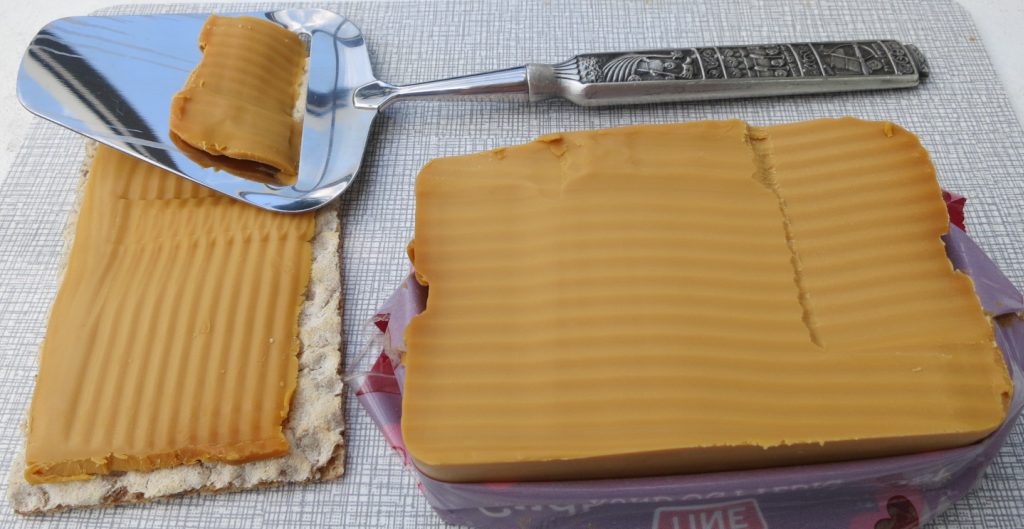
1. Brown Cheese (Brunost)
Norway’s Sweet, Addictive Secret:
Imagine cheese, but make it caramelized. Brunost is Norway’s unofficial national cheese, made from whey and packed with a sweet, nutty flavor. It’s weird at first, but once you get it? Game over.
Where Did Brunost Come From?
Brunost’s origins date back hundreds of years to when Norwegian farmers made the most of every part of their milk supply. Early versions of brunost were made with only goat’s whey, but it was in the 1860s that a woman named Anne Hov, a dairymaid from Gudbrandsdalen, revolutionized the recipe. She added cream and cow’s milk to the whey, creating what we now know as Gudbrandsdalsost, the most popular variety of brunost today.
Anne Hov’s innovation saved the struggling dairy industry in her region, and she eventually received royal recognition for her contribution to Norway’s food culture.
Where to Eat It:
Ostebutikken (Oslo) – One of the best places to taste artisan brunost.
Undredal Stølsysteri (Undredal) – A small mountain farm where you can watch the cheesemaking process.
Pro Tip: Try it on fresh waffles with a smear of sour cream. Thank us later.

2. Norwegian Waffles
Norway’s Ultimate Snack
Norwegian waffles are thinner, crispier, and heart-shaped, and they’re not drowned in syrup. Instead, they’re topped with brunost (yep, again) or homemade jam.
Norwegian waffles, or vafler, have been a beloved part of Norway’s food culture for centuries, tracing their origins back to the Middle Ages when waffle irons first made their way into Scandinavian kitchens. Unlike the thick, crunchy Belgian-style waffles, Norwegian waffles are thin, soft, and heart-shaped, making them a unique staple of the country’s culinary heritage. Traditionally, they were enjoyed by farmers and fishermen as a simple, satisfying treat, often served with sour cream, homemade jam, or the iconic brunost (brown cheese).
Over time, waffles became a social food, served at cozy gatherings, roadside cafés, and mountain lodges, perfect for warming up after a long day in Norway’s rugged landscapes. Today, you’ll find vafler everywhere—from family kitchens to ski resorts, still prepared using time-honored recipes that have been passed down through generations. Want the full Norwegian experience? Pair your waffle with a cup of strong coffee and enjoy it like a true local.
Where to Eat It:
Baker Brun (Oslo) – For vaflers, pastries, cake and bread.
Haralds Vaffel (Oslo) – A little kafé in the trendy Grünerløkka neighborhood.
Foodie Experience: Join a waffle-making class in Oslo to learn how to make these heart-shaped beauties from scratch. (Book here)
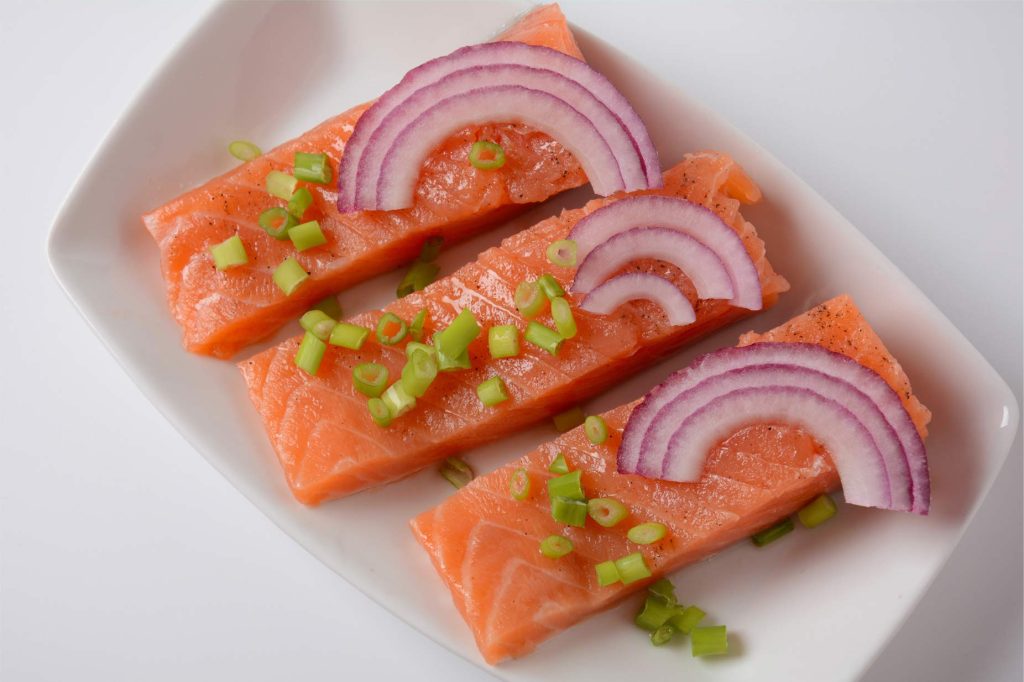
3. Rakfisk
Norway’s Fermented Fish That Packs a Punch
Rakfisk, Norway’s notorious fermented fish, has been a staple of Scandinavian cuisine for over 500 years, dating back to the Viking Age. Originally developed as a preservation method, rakfisk was a way for Norwegians to store fish through the harsh winters before refrigeration existed. Traditionally made from trout or char, the fish is salted and left to ferment in barrels for two to six months (or even longer!), developing its strong, tangy aroma and intense umami flavor.
While its potent smell might scare off first-timers, Norwegians consider it a delicacy, especially when served with flatbread, sour cream, red onion, and aquavit. Today, rakfisk is celebrated at the annual Rakfisk Festival in Fagernes, where thousands gather to sample different varieties and embrace this ancient Nordic tradition. Despite its bold reputation, eating rakfisk isn’t just about the taste—it’s a cultural experience, a connection to Norway’s fishing heritage, and a true test of adventurous eating.
Where to Eat It:
Rakfisk Festival (Fagernes) – The biggest celebration of Norway’s most divisive dish, held every year in the fall.
Noraker Farm (Aurdal) – Dine at the farm restaurant or take a guided tour of the farm and kitchen, complete with award-winning Rakfish tasting.
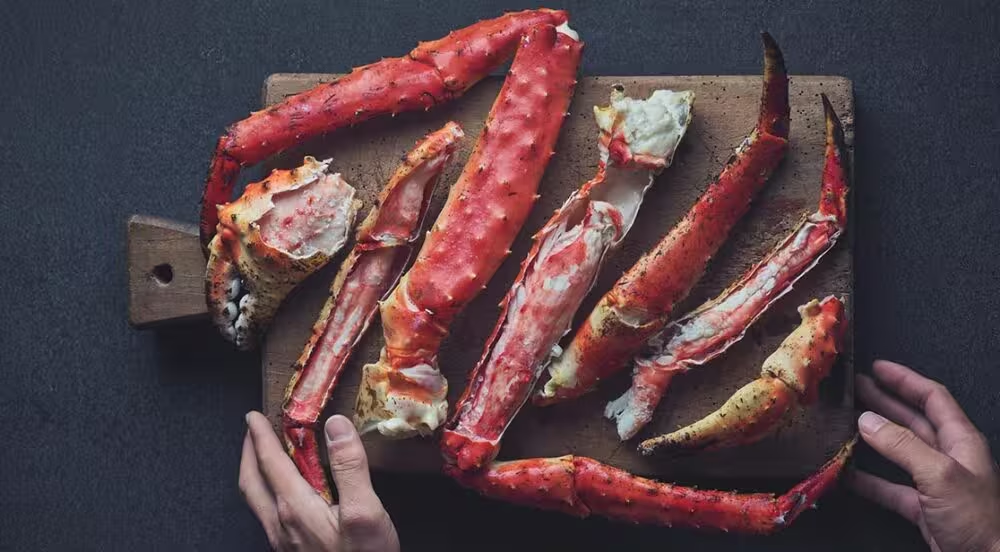
4. King Crab
Norway’s Seafood Trump Card
Norwegian king crab is next-level fresh because it comes straight from Arctic waters. These bad boys can grow over 10 kilos and taste like buttery, ocean magic.
King crab fishing in Norway is more than just a seafood delicacy—it’s a major industry and a testament to the country’s fishing heritage and Arctic resilience. The red king crab wasn’t always native to Norway; it was introduced from Russian waters in the 1960s and quickly spread along the northern coast, particularly in Finnmark. While initially seen as an invasive species, Norwegian fishermen recognized its economic potential, turning it into a thriving industry that now supplies some of the most sought-after seafood in the world.
Towns like Kirkenes and Honningsvåg have become hubs for king crab safaris, where visitors can join local fishers, pull up massive crabs from the icy Barents Sea, and enjoy fresh, buttery crab straight from the source. Beyond tourism, the industry provides critical income for coastal communities, and strict sustainability measures ensure that king crab fishing remains environmentally responsible. Today, Norwegian king crab is considered one of the world’s finest delicacies, making it both a symbol of Arctic bounty and a must-try experience for food lovers.
Where to Eat It:
Havly (Honningsvåg) – The king crab capital of Norway.
Fjellskål Seafood (Bergen) – If you love seafood, this is heaven.
Foodie Experience: Go on a King Crab Safari in Kirkenes—catch your own crab and eat it fresh! (Book here)
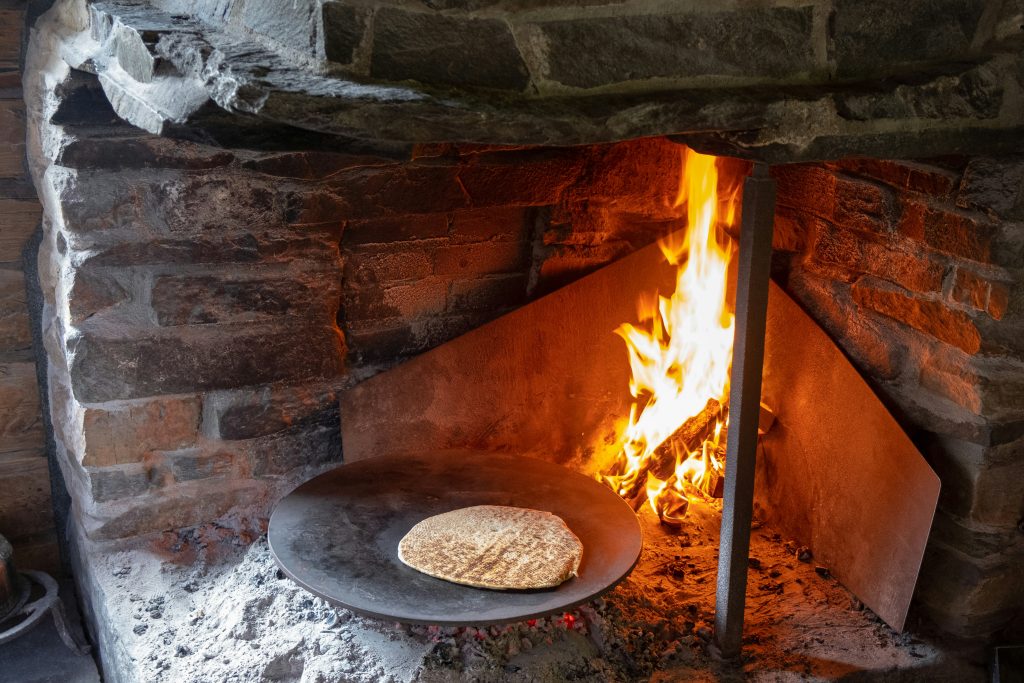
5. Lefse
Norway’s Soft, Sweet Flatbread
Soft, chewy, and lightly sweet, lefse is the comfort food you didn’t know you needed. It’s basically a potato-based tortilla, but better.
Originally developed as a way to preserve grains and potatoes for the long winters, lefse has been a staple in Norwegian households for centuries. It comes in many regional varieties, from thin and delicate dessert-style lefse rolled with butter, sugar, and cinnamon to heartier versions meant to be eaten with savory toppings like cured meats and brunost. What makes lefse truly special is its connection to holiday traditions—it’s a must-have during Christmas, family gatherings, and celebrations, often made together as a communal activity.
Many families pass down lefse-making techniques through generations, using special rolling pins and griddles to get the perfect thin, soft texture. Today, travelers can find freshly made lefse at bakeries, cafés, and local markets or even join a lefse-making class to experience this beloved Norwegian tradition firsthand. Whether served sweet or savory, lefse represents Norwegian hospitality, warmth, and a delicious connection to the country’s culinary past.
Where to Eat It:
Bakeriet i Lom (Lom) – A legendary bakery making old-school lefse.
Norsk Folk Museum (Oslo) – Norway’s largest museum of cultural history, with buildings dedicated to the different regions in Norway – some dating back to 1200 – and a cafe with, yes, lefse. Check out the website where they even share the recipe so you can try your hand at baking lefse wherever you are.
Foodie Experience: check out all the regional specialties that start with lefse
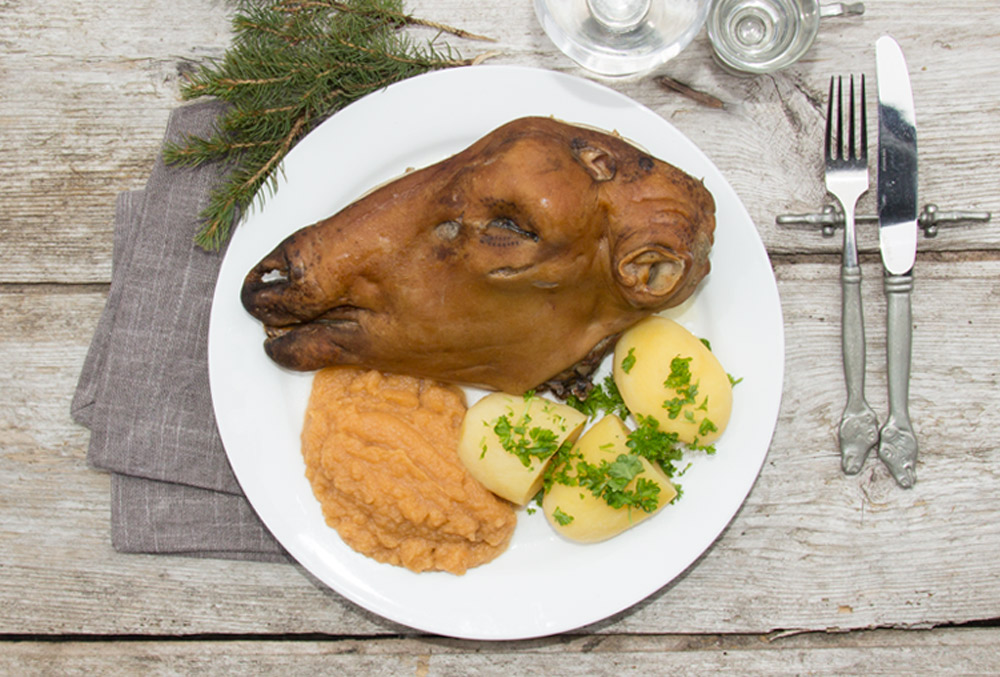
6. Smalahove
The Viking-Style Sheep’s Head
Because who else is eating slow-roasted sheep’s head like a boss? This dish is straight out of Viking tradition and is still a favorite in Norway today.
Originating in western Norway, particularly in Voss, smalahove was historically a peasant food, a way for rural communities to use every part of the animal and minimize waste—an early example of sustainable eating. The dish is prepared by removing the wool, drying and smoking the head, then slow-boiling it until the meat becomes tender and rich in flavor. Traditionally served with rutabaga mash and potatoes, smalahove was once considered a luxury food for Christmas, though today it’s enjoyed year-round by adventurous eaters.
While some locals still swear by eating the eyes and tongue first (considered the best parts!), smalahove is now more of a cultural experience than an everyday meal. Visitors can try it in Voss, where it remains a specialty, and learn about Norway’s nose-to-tail cooking heritage, which values resourcefulness and respect for food. Though not for the faint of heart, smalahove is a true taste of Norwegian history and tradition.
Where to Eat It:
Smalahovetunet (Voss) – The place to go for authentic smalahove. Voss even hosts an annual Smalahove festival – usually in September.
BONUS!
Here are some other must-try Norwegian foods:
7. Klippfisk (Salted & Dried Cod)
What It Is: Cod that’s been salted and air-dried, originally created for long Viking voyages.
Why It’s Special: This dish helped Norway become a seafood superpower, and it’s been eaten here for over 500 years.
Where to Try It: Sjøstjerna (Kristiansund) – one of Norway’s best klippfisk restaurants.
8. Rømmegrøt (Sour Cream Porridge)
What It Is: A creamy, rich porridge made with sour cream, butter, and flour.
Why It’s Special: It’s an old-school Norwegian comfort food that’s often eaten at celebrations.
Where to Try It: Frognerseteren (Oslo) – a mountain lodge serving traditional dishes.
9. Pinnekjøtt (Cured Lamb Ribs)
What It Is: Salted and dried lamb ribs, usually steamed over birch branches.
Why It’s Special: It’s a Christmas tradition in Norway and has a smoky, savory flavor unlike anything else.
Where to Try It: Lofoten Fiskerestaurant (Oslo) or a home-cooked meal with Norwegian friends (if you’re lucky!).
10. Tørrfisk (Stockfish)
What It Is: Air-dried cod, hung outside for months to preserve it naturally.
Why It’s Special: It’s one of Norway’s oldest export goods, dating back to the Viking Age.
Where to Try It: Anita’s Sjømat (Anita’s Seafood – Reine, Lofoten Islands) – the heart of Norway’s stockfish industry, the fish hangs from the rafters above your head in the dining room.
11. Kvæfjordkake (Norwegian “World’s Best” Cake)
What It Is: A layered meringue, almond, and vanilla cream cake that Norwegians proudly call Verdens Beste (The World’s Best).
Why It’s Special: It’s Norway’s national cake, and yes, according to Norwegians it really is that good.
Make the most of Norway’s food scene.
From fermented fish that’ll test your limits to caramelized cheese that’ll change your life, Norway has its own unique flavors, and we’re here for it. Whether you’re hitting up Oslo’s street food scene or learning how to make lefse from scratch , you’ll walk away with epic flavors and unforgettable experiences.
Would you try that Viking sheep’s head? Drop us a comment below!
#FoodieTravel #SustainableTravel #NorwegianFood #HiddenGems